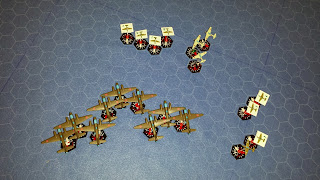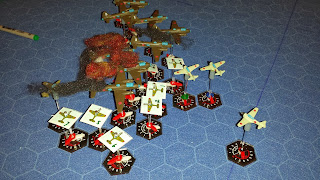My Wife Loves Me! She
Really Does!!! She was really nice to me
and I got a really nice Christmas Gift!
It’s nice to have a wife that supports my habits! ;)
So, what’s in the box?
LOTS!!!
- Hard Cover Copy of the Firestorm Armada Rules – Version 2
- Soft Cover Scenario Book with escalating (training) missions using the models of the set
- 6 full colour cardstock pages with counters, asteroids, turn templates and the new “Battle Logs”
- 2 sets of dice – 1 normal, 1 smaller to fit into the new Short Range Spaceship (SRS) tokens
- 2 Sets of Tactical Ability Cards (TAC) – 1 generic, 1 of race-specific cards
Opening the Box!
Lotsa Bubble Pack!
And
2 fleets:
Terran
Alliance:
1 Tyrant Battleship
·
3 Teuton Cruisers
·
4 Armsmen Frigates
·
4 Large SRS Tokens
·
4 Small SRS Tokens
·
The Valhalla Research Station
The Terran Fleet
Two-Piece Cruisers
Single-Piece Frigates
The Tyrant Battleship (with Frigates)
The Valhalla Station
Dindrenzi Federation:
·
1 Praetorian Battleship
·
3 Secutor Cruisers
·
3 Thaex Frigates
·
2 Large SRS Tokens
·
2 Small SRS Tokens
One-Piece Frigates
Three (Four?) Piece Cruisers
The Praetorian Battleship
Various SRS Tokens
And, of course, a ton of flight stands for everything
(except the station – which is free-standing)
All the resin parts were nicely wrapped in bubble pack and
the over-all impression I had when I first opened the box was “WOW! Nicely packed and FULL!!!”
Something of special note: All the colour cardstock was
die-cut! I just had to punch out the
various bits! No cutting with
scissors! Bravo! I hope Spartan continues to do this with all
the box sets!
Impression of the
Models:
As you can see in the photos, I haven’t yet started
assembling anything (YET!). Overall, the
detail is excellent for all the ships.
Very little flash, though there will be some clean-up required to add
the engines to the larger Battleships. The
worst of the flash seems to be on the SRS tokens, on the bottom edge, so I’m quite
happy with the quality.
If I do have a complaint, it’s that there are no instruction
diagrams. This is a common problem with
several manufactures. I suspect the
issue here is that when the product is packaged as individual blisters or as the new
Patrol Boxes that Spartan is pushing now, it’s obvious what goes where. Unfortunately, here you have 2 different
fleets and a lot of bits for both are jammed in with the SRS tokens in a single
Ziploc bag, so you have to sort through the parts and guess where each bit
goes. In honesty, I’ve already figured
out where most of the bits go, just by comparing photos on the box cover. There is one small bit I haven’t figured out
yet, but that’s not too bad…
I’ll try to let you know what I think as I assemble and
paint the fleets.
Firestorm Armada
V2 Book: First Impressions
First, a confession: I’ve never played a Firestorm Armada
game before. Like many people, I’ve
downloaded the PDF file of Ver 1.1 directly from the Spartan Game’s site, so
what you’ll see here is my first impression of the book and rules.
The quality of the book is excellent. While only 120+ pages, the hard cover is
excellent quality and the pages are all full colour and the text is easy to
read. Some gorgeous photos and some good
example diagrams dot the test as you progress through the rules, though
sometimes they don’t always seem to be where you’d thing find them. The book does have an index (though I’m not
sure how good it is; after playing a few games and having to reference things,
I’m sure I’ll find out).
The sequencing of the book is very “British” in style. The rules are not laid out in a point system for
reference like some “American” games (such as the notorious Star Fleet
Battles). The sections of the book are
laid out in a fairly logical, sequential order:
- · The story behind the game (“Fluff”)
- · Basic Game Concepts (where to measure from, dice rolling and modifiers, model stats and definitions, etc.)
- · The Turn Sequence and brief explanations
- · The Movement Phase
- · Combat
- · Weapons
- · Firing Options
- · Boarding
- · End Phase
- · Rules for Short Ranged Spacecraft (SRS)
- · Model Assigned Rules (MAR) (All the Special Rules that give the different fleets their flavor).
- · Scenarios
- · Generic Fleet Lists (Basic Battleship, Cruiser and Frigate for each race/fleet)
If you’ve experienced a Spartan Games rule set before, then
you’ll be familiar with the layout of the rule set. One of the things that has improved is that
Spartan has added page references any time they reference a subject that’s
covered in more detail elsewhere. This
makes cross referencing much faster as you don’t have to jump back to the index
or the table of contents for everything.
The Rules:
Well, Firestorm Armada uses most of the same basic rule
concepts as Dystopian Wars:
- · Alternating activations between players
- · Exploding 6’s: a natural 6 counts as 2 hits and gains another dice roll
- · Roll to see how many hits and if you exceed the Damage Rating (DR) or Critical Rating (CR) you cause damage
- · Weapons have Range Bands to determine how many dice you roll, depending on distance
So, what has changed between V1 and V2 of Firestorm and
Dystopian Wars?
First, the fleet organization and “Battle Size” definitions
have changed. Instead of basing your
fleet organization on the percentages of a battle size, now you “pick a Fleet
type”: Patrol Fleets (800 pts. or less), Battle Fleets (801 – 1200 pts.) or
Grand Fleets (1201 – 2000 pts.). The
various fleet lists (downloadable from the Spartan Website Download section)
then define what you’re allowed to take in each of the 3 “Tier”. Each Tier is approximately the same as the
Large / Mediums / Smalls of the previous version (though some Tier 1 choices
are composed of Medium ships) For
example, the Terran’s fleet list limits the player from taking more than 2 Tier
1 (Heavy) choices in a “Patrol Fleet”, and a further limitation says only 1 of those
could be a Battleship.
A new feature is that most Medium and Large Vessels now have “Hardpoints”
and “Upgrades” introduced in the fleet lists.
A Hardpoint allows the player to add capabilities to their ships,
creating some (limited) customizations whereas Upgrades tend to be MAR changes
to the ship. Both features add cost to
your basic ship.
The STAR cards are gone; replaced by the TAC cards. And they aren’t random, they’re chosen in
advance (though you are limited on how many cards and which cards you chose as some are
race-specific).
There are two different “Weapon System” Fire Phases, one for
Direct Fire and one for Indirect Fire.
Direct Fire weapons must all be fired and resolved before you can shoot the
Indirect Weapons. Both types of weapons
are fairly well defined so there should be no confusion there. Also, you still must declare ALL attacks
before you fire your first weapons.
Another change is that there are different weapon “types”
defined. The significance of this is
that different types have different Range Bands. Instead of all Range Bands being multiples of
8, they are multiples of 8”, 10” or 12”!
As an extra; many weapon types have a bonus rule that grants an
advantage for using that type of weapon by itself under certain conditions.
While Linked Fire and Combined Fire are still firing
options, Split Fire was removed and instead given as a Model Assigned Rule: not
everyone can split their weapons fire from a single mount anymore!
Another huge change is the handling of Short Range
Spacecraft (SRS: fighters, bombers, etc.).
Besides the new tokens, SRS must stay within Command Range of their
Carrier UNLESS they are making an attack run.
That attack run is limited to the distance that the SRS wing can go in a
single movement phase! No more launching
bombers and sending them around the moon to ambush from the other side in 2-3
turns!
The final change I’ll talk about is the new preferred Victory
System using the Battle Log. The Battle
Log is used to track each fleet’s progress as they destroy enemy vessels and
squadrons, complete objectives or lose their own fleet’s vessels. The first player to reach the designated winning
point value wins the game. Patrol
Battles go until 10 pts., Battle Fleet Battles go until 15 pts. and Grand Fleet
Battles go until 20 pts. What is unique
is you can “give up” points to gain advantages or re-gain the use of TAC cards,
though you still need to re-gain those points to earn a Victory later. The old “Victory Points” system based on
vessel point costs is also shown in the book, but the new scenarios are based
on the use of the Battle Log to determine Victory or level of victory.
Overall, I found the rules fairly straight forward to follow
and understand, though there are a few points I needed to re-read and I’m
looking forward to an FAQ for couple of issues.
The organization of the rules is sort of sequentially-based so there
were a few places you need to jump to a different section to work out how
things would work in a true battle situation.
The Quick Reference pages in the back of the book has all the tables
listed in the book, but I’d like to see a quick weapons table listing the range
band and “Coherence Effect” as some Upgrades will change the weapon types and a
list of SRS capabilities included.
Someone will make up another reference chart, I’m sure!
Anyway, I’m looking forward to getting things assembled and
testing out the new rule set soon. I
hope you’ve enjoyed this review and got something from it!
Good Luck with your dice!



































